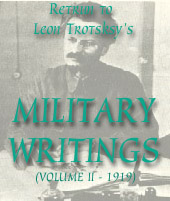
1. The approaching conclusion of the civil war and the changes for the better in Soviet Russia’s international situation make urgent the question of radical changes in the sphere of our military activity, in accordance with the country’s pressing economic and cultural needs.
2. At the same time we must be clear that, so long as the imperialist bourgoisie remains in power in the most impor tant countries in the world, the socialist republic cannot consider itself secure.
The further course of events may at a certain moment cause the imperialists, who feel the ground slipping away under their feet, to hurl themselves into bloody adventures directed against Soviet Russia.
This means that the military defence of the revolution has to be maintained at the proper level.
3. To the present period of transition, which may last for a long time, must correspond an organisation of our armed forces such that the working people acquire the necessary military training with the least possible distraction from productive labour. This system can only be a Red Workers’ and Peas ants’ Militia constructed on territorial principles.
4. The essence of a Soviet militia system must consist in bring ing the army close in every possible way to the process of production, so that the manpower of particular economic areas is simultaneously the manpower of particular military units.
5. In their territorial distribution the militia units (regiments, brigades, divisions) must coincide with the territorial layout of industry in order that the industrial centres, together with the agricultural peripheries which surround them and gravl tate towards them, may constitute the basis for the militia urnts.
6. Organisationally, the workers’ and peasants’ militia must be based upon cadres that are fully trained in military, technical and political respects, and that maintain a permanent record of the workers and peasants whom they train, so as to be able at any moment to draw them forth from out of their militia districts, surround them with the apparatus constituted by these cadres, arm them, and lead them into battle.
7. Going over to the militia system must inevitably be a gradual process in conformity with the military and the international diplomatic situation of the Soviet Republic, with unfailing observance of the condition that the latter’s defence-capacity must always be kept at the proper level.
8. As the Red Army is gradually demobilised, its best cadres must be allocated territorially in the most expedient fashion, that is, most closely adapted to local conditions of production and way of life, so as to ensure that there is an apparatus ready to administer the militia units.
9. The personal composition of the militia cadres must then be gradually renewed in such a way as to ensure the closest ties with the economic life of the given areas, so that the com manding personnel of a division which is situated in a territ ory that includes, for example, a group of mining enter prises, with a rural periphery attached to them, shall consist of the best elements of the local proletariat.
10. With a view to bringing about this renewal of the cadres, command courses must be distributed territorially in con formity with the economic and militia districts, and the best representatives of the local workers and peasants must be put through these courses.
11. Military training on militia principles, which is to ensure that the militia-type army possesses a high degree of combat-readiness, shall consist of:
12. The organisation of militia cadres assigned to the task of military defence of the country must be adapted to the necessary extent to the performance of labour service, that is, it must be able to form labour units and to supply them with the necessary apparatus of instructors.
13. While developing in the direction of becoming a communist people in arms, the militia must, in the present period, retain in its organisation all the features of the dictatorship of the working class.
February 28, 1920
40. The Ninth Congress of the Russian Communist Party was held on March 29-April 4, 1920. The items on the agenda were: the Central Committee’s report, the immediate tasks of economic Construction, the trade-union movement, organisational problems, the tasks of the Comintern, going over to the militia system, etc. The theses were adopted by the Congress, together with a resolution, on the basis of Comrade Trotsky’s report.

Last updated on: 23.12.2006